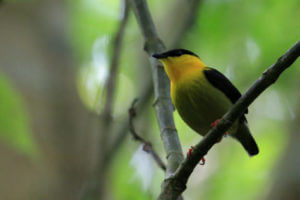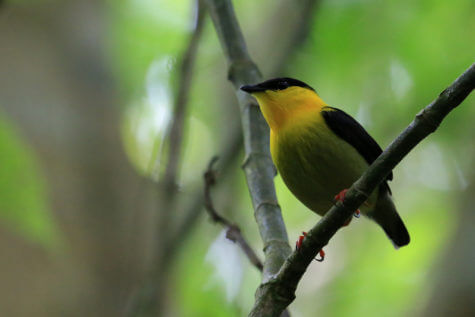PANAMA CITY — In the torrid jungle, his body coursing with testosterone supplements and his focus set entirely on a female, the young male takes action. Compelled by his biology, there is only one thing he can do… clean the floor.
Working out of the Smithsonian Tropical Research Institute (STRI) in Panama, researchers find that male golden-collared manakins — a small bird primarily found in Panama and Columbia, and named appropriately for its bright neck — doubled-down on their cleaning behavior when treated with testosterone. With their courtship displays requiring an area of the forest floor to be cleared of debris, the tropical birds went into cleaning overdrive when given the hormone.

“We wanted to know if hormones influenced the manakins’ drive to clean up their mating display area, so we treated juvenile males and females with testosterone,” says STRI post-doctoral fellow Ioana Chiver in a press release. “Testosterone-treated young males really got into cleaning up the display court. They removed significantly more leaves than untreated males and even pulled up small tree seedlings.”
With their bright-yellow beards on full display, the manakins show off in groups called “leks” on their freshly-cleared dance floors. Performing leaping acrobatics and snapping their wings together above their heads, the manakins expend quite a bit of energy in the spectacle.
Looking to see just how far they would go to get their stage in tip-top shape, the researchers even added weights to the underside of leaves cluttering the performance area. The scientists reported that some of the testosterone supplemented males ended up flying away with leaves weighing as much as their own body.
As the weighted leaves presented much more of a challenge to the birds, Chiver noted that the adult males found novel ways to remove the cumbersome debris.
“We think of younger animals as being more innovative,” she notes, drawing attention to the study’s possible implications on age and innovation. “But here we see that hormones may be playing a role in motivating the birds to persistently seek new ways to court their mates.”
The researchers also drew comparisons to the studies of bowerbirds, which to attract mates employ similar cleaning behavior and also create elaborate sculptural constructions of stones, twigs, and colorful objects.
In bowerbirds, the scientists said juvenile males also respond to testosterone treatment with increased bower construction. However, they note, “the complexity of the display and bower structure also increases with age, pointing to an important role for experience, as males learn from being assessed by visiting females and juveniles.”
While such tropical bird studies don’t provide enough data for any strong conclusions on the relationship between age, testosterone, and innovation outside of their species, they do point to an interesting area for future study.
As far as observations of the effects of testosterone on female birds, the researchers found an interesting mix of results.
“Even when treated with testosterone, females were not motivated to clean the male’s display area, although they did become more aggressive and show some other male display behaviors,” explains Barney Schlinger, co-author and professor at UCLA. “That tells us that hormones alone are not enough: testosterone is activating specific neural circuits in males. Females either do not have these circuits, or they are insensitive to testosterone.”
Calling the experiments “ingenious,” STRI scientist emerita Mary Jane West-Eberhard also cautioned against reading too much into any one aspect of such studies.
“Their results remind us that the way an animal behaves and the way its genes are expressed — often powerfully influenced by hormones — depend on the animal itself, whether it is male or female, and how it formed during development at the time when the hormones and genes act,” she says. “We should be wary of often simplistic beliefs that sexual behavior is determined by genes or hormones alone.”
The study findings were published yesterday in the journal Animal Behavior.

Comments
Comments are closed.